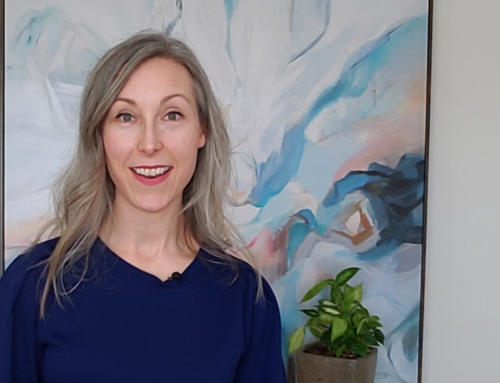Setting boundaries around your schedule and leaving the office—even your home office (maybe even especially your home office)—at a specific time every day is something that will help enormously.
If you master this concept you will
- experience greater satisfaction with your work
- likely even get more work done than before
- feel less stress and anxiety
- be on your way to creating healthy habits to support you
Because you’re no fun when you’re exhausted and overwhelmed all the time.
I know I sure wasn’t when I struggled with burnout while I led the communications for a $50M company.
There, I had been working at the office until 7 or 8 at night pretty regularly. Sometimes I even worked at the office until 10 or 11 p.m. Then I’d come home, scarf down some food and do more work usually until midnight or 1 am. Obviously, this wasn’t working for me and I wanted to change that. So I set boundaries, but–and this is important!
I set them WITH MYSELF.
I had a realization.
No one was forcing me to work those hours. I was choosing to work those hours to try to get ahead because I always felt like I was behind, or that I was going to drop a ball. And my to-do list was never done. I really felt trapped, like so many of the people who work more closely with me.
What’s the takeaway here? You need to set boundaries WITH YOURSELF.
Here is how you can go about doing that. It’s SIMPLE but not necessarily easy.
There are two steps. I’ll lay them out for you first and then go into each one in more detail.
Step #1: You need to change your mindset.
Step #2: To change your mindset, you need to look your fears in the face.
Here’s is what I mean.
In order to take action and leave the office at a specific time, it likely means you will need to get up from your desk. You’ll have to get up when you know you have a ton of stuff still left to do. It’s going to feel really uncomfortable. It may even trigger some anxiety at first when you first start working less and sticking to those boundaries that you set for yourself.
Fear is driving you
When you’re trapped in that cycle feeling like you need to put in the extra hours to get ahead, you’re usually motivated by fear. The fear that you’ll drop a ball, that you’ll fall even further behind, that you might miss something and if any of those things happen something bad will happen. That you’ll experience DIRE CONSEQUENCES. That’s the fear.
You don’t know exactly what that bad thing is because if you’re like me, you don’t look at or acknowledge that fear because it’s terrifying. (It’s a very human thing.) And so this dark, scary cloud hangs over your shoulder and holds incredible power over you.
In fact, that fear is holding you hostage, and it’s what’s keeping you stuck in what can feel like a never-ending cycle. Because we can tell ourselves things like,
“It’s just until this project is over. Once it’s done, then I can rest.”
Sound familiar?
But just when you get up to that light at the end of the tunnel, you realize it’s your boss with a torch handing you more work to do. And if you’re an entrepreneur, you are your boss and so you can think of that as your next great idea that you’ll need to dig deep for. Or the next project you need to get going to keep the cash flowing. Again. And so the cycle continues.
Changing these thoughts, this mindset around why you need to keep working, is critical.
And that takes us to Step 2:
To change your mindset, you need to look your fears in the face.
Let’s look at those fears. They are going to be a bit different for everyone but have similar themes. Maybe it’s that you’ll get fired from your job if you don’t put in the hours. Maybe for those of you in business, it’s that you’ll lose all of your clients and have to get a day job.
In whatever way this fear shows up for you know this: The fear is usually based on a FICTIONAL worst-case-scenario. That’s worth repeating: a fictional worst-case scenario. We make assumptions about all of the bad things that could happen, and they’re usually not realistic.
- I’ll get fired.
- I’ll lose all of my clients.
- I won’t make any money.
Take a look at what your fear is. What is that worst-case scenario? Look that dark cloud in the eyes. And once you’ve identified that fear, ask two questions:
- How likely is this to happen?
- What are the blessings that could result from this worst-case scenario?
Let’s take the losing all of your clients and needing to get a day job worst-case scenario. How likely is that to happen? Not really. You’d have to do something pretty drastic to lose all of your clients suddenly. What are the blessings of needing to get a day job? Steady pay cheque, pay bills, usually have some benefits.
When you come face to face with the worst-case scenario, you realize, OK. It’s actually not that bad.
To recap how to set boundaries around your work schedule do you can create better balance,
Step 1: Change your mindset.
Step 2: To change your mindset, look your fears in the face.



